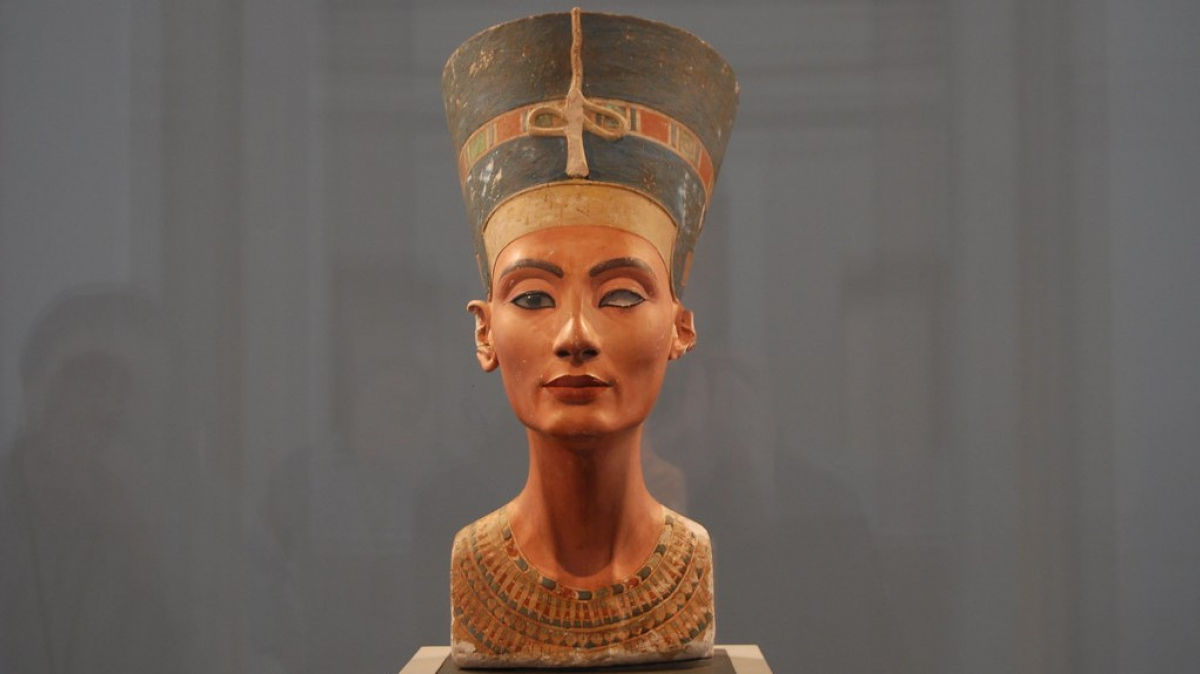
Nefertiti, the wife of King Akhenaten and Queen of Egypt, is a mystery to Egyptologists and represents a true legend to the public. The famous bust found by archaeologists and exhibited at the Neues Museum in Berlin contributed to the myth that surrounds Nefertiti: her beauty is renowned beyond the millennia.
[predef]mh-general-eng-489[/predef]
Who was Nefertiti
Nefertiti was the Queen of Egypt during Dynasty XVI in ancient Egypt. Nefertiti became the Great Royal Bride of Pharaoh Amenhotep IV (or Amenophis or Akhenaten, 1353 / 52-1338 BC). Much of the history of this sovereign and that of this time are subject to controversy.
To begin with, the origin of Nefertiti herself is up for debate, because there are doubts about her identity. What is known is that her name evoked the myth of the goddess Athor.
Sometimes, Nefertiti is identified as Princess Tadukhepa, daughter of Emperor Tushratta and wife of the previous king Amenhotep III, who changed his name when he remarried. Another hypothesis tells us that Nefertiti was probably the daughter of Amenhotep III and Queen Tiyi I, therefore a full-fledged Egyptian princess.
Nefertiti and Akhenaten
Irrespective of her origin, Nefertiti became the Great Royal Wife of Akenaton IV in year 3, or the beginning of year 4, of his reign. She also served as Divine Wife of Amun.
It is not clear how much of an active role Nefertiti played in her husband's reign, but there is evidence to suggest she was significantly involved in the decision-making process. Unlike other pharaohs, Akhenaten did not seem to have had concubines or a harem and is often depicted in positions of power alongside Nefertiti: they reigned together.
Nefertiti had six daughters with Akhenaten:
- Meritaten
- Meketaten
- Ankhesenpaaten
- Neferneferuaten Tasherit
- Neferneferure
- Setepenre
The majority of specialists agree that she was the mother of Tutankhamun, who was officially the son of Akhenaten and one of his sister. Queen Nefertiti is represented in the temple of Aton in Karnak and specialists have highlighted how the Pharaoh chose to immortalize Nefertiti in a traditional Pharaoh pose - wearing his crown and smiting enemies. Nefertiti was the only queen represented in this way.
The princess of the Nile participated substantially in the development of the new religion dedicated to Aton during religious ceremonies, along with her husband, who carried the title of "High Priest of Aton." Her influence with the king, her prestige and power did not stop growing until her strange disappearance.
Nefertiti's reign was innovative in many areas. A new artistic tradition, full of sensuality, adhering to a new aesthetic code was born during this period. The princess of the Nile, the Queen of Egypt, together with Akhenaten, represented the most connected couple since Amenophis III and Tiy.
Nefertiti and Akhenaten are shown together in the ceremonies, but, as a novelty for Egyptian royalty, some official art from the time depicts them in familiar scenes considered far too intimate to be shown.
Akhenaten and Nefertiti could have separated in the last years of his reign, and one primary reason is the fact that his eldest daughter, Meritaten, replaces the princess of the Nile in ceremonies with the king and takes the title of "mistress of his house." The reasons for this separation may have been political, although Egyptologists are still investigating this matter.
Nefertiti's disappearance
The end of the queen's life is a great enigma, and she disappeared from the public scene around year 12, after the celebration of the death of her second daughter, Maketaten.
From this period onward, she vanished from the political and public life of Amarna. Her name was even erased in the monuments where Meritaten replaced her.
Some specialists suggested that in a possible misfortune Nefertiti could have been killed by her rival, Kiya, or perhaps she succumbed to an illness
Thus, many specialists agree that the death of Nefertiti is also mysterious, and we do not know precisely when or how she died, nor where her remains are. It seems increasingly unlikely that the Queen of Egypt has been buried in the royal tomb (TA26) of Amarna, even though she was assigned a room in the unfinished suite of Akhenaten's burial chamber.
Other Egyptologists, such as Joann Fletcher, publicly announced that one of the two unidentified mummies discovered in tomb KV35 in 1898, which was dubbed "Younger Lady" was Nefertiti's, based on the mummification technique used.
Other theories tell us that Akhenaten rests in Amarna and, after the death of Nefertiti, her body was placed next to her husband's, although it is unknown if the remains were destroyed during the desecration or if they were transferred to Thebes when Amarna was abandoned.
The Nefertiti bust
Almost thirty-four centuries after her death, Queen Nefertiti remains one of the most desired women in Egypt. Her bust, a masterpiece of ancient Egyptian art exhibited at the Neues Museum in Berlin, has been ardently claimed since the 1930s by authorities in Cairo.
Discovered in 1912 in Tell el-Armana, Egypt, by the German archaeologist Ludwig Borchardt, the bust was illegally moved to Germany, and this is why, a century later, the struggle for its ownership continues.
